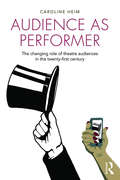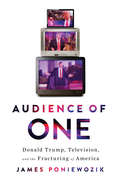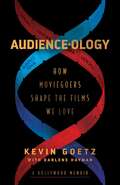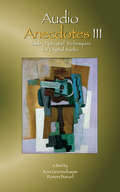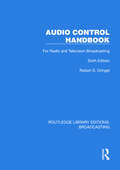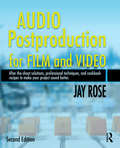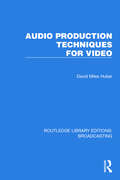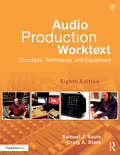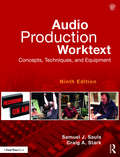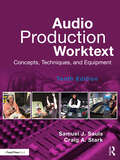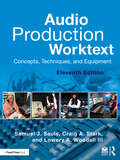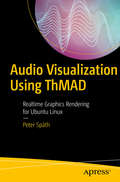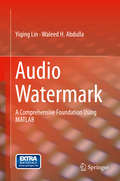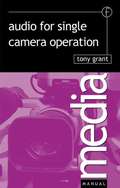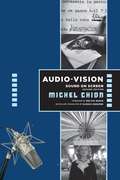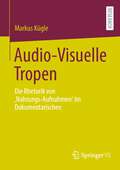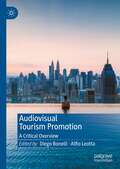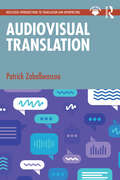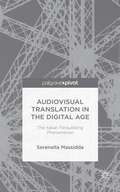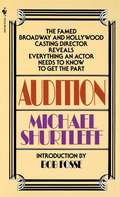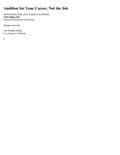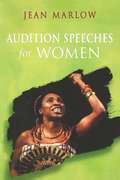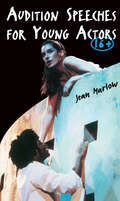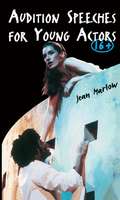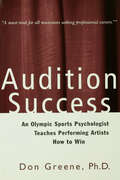- Table View
- List View
Audience as Performer: The changing role of theatre audiences in the twenty-first century
by Caroline Heim'Actors always talk about what the audience does. I don’t understand, we are just sitting here.' Audience as Performer proposes that in the theatre, there are two troupes of performers: the actors and the audience. Although academics have scrutinised how audiences respond, make meaning and co-create while watching a performance, little research has considered the behaviour of the theatre audience as a performance in and of itself. This insightful book describes how an audience performs through its myriad gestural, vocal and paralingual actions, and considers the following questions: If the audience are performers, who are their audiences? How have audiences’ roles changed throughout history? How do talkbacks and technology influence the audience’s role as critics? What influence does the audience have on the creation of community in theatre? How can the audience function as both consumer and co-creator? Drawing from over 140 interviews with audience members, actors and ushers in the UK, USA and Austrialia, Heim reveals the lived experience of audience members at the theatrical event. It is a fresh reading of mainstream audiences’ activities, bringing their voices to the fore and exploring their emerging new roles in the theatre of the Twenty-First Century.
Audience of One: Donald Trump, Television And The Fracturing Of America
by James PoniewozikOne of the Top 10 Politics and Current Events Books of Fall 2019 (Publishers Weekly) An incisive cultural history that captures a fractious nation through the prism of television and the rattled mind of a celebrity president. Television has entertained America, television has ensorcelled America, and with the election of Donald J. Trump, television has conquered America. In Audience of One, New York Times chief television critic James Poniewozik traces the history of TV and mass media from the Reagan era to today, explaining how a volcanic, camera-hogging antihero merged with America’s most powerful medium to become our forty-fifth president. In the tradition of Neil Postman’s masterpiece Amusing Ourselves to Death, Audience of One shows how American media have shaped American society and politics, by interweaving two crucial stories. The first story follows the evolution of television from the three-network era of the 20th century, which joined millions of Americans in a shared monoculture, into today’s zillion-channel, Internet-atomized universe, which sliced and diced them into fractious, alienated subcultures. The second story is a cultural critique of Donald Trump, the chameleonic celebrity who courted fame, achieved a mind-meld with the media beast, and rode it to ultimate power. Braiding together these disparate threads, Poniewozik combines a cultural history of modern America with a revelatory portrait of the most public American who has ever lived. Reaching back to the 1940s, when Trump and commercial television were born, Poniewozik illustrates how Donald became “a character that wrote itself, a brand mascot that jumped off the cereal box and entered the world, a simulacrum that replaced the thing it represented.” Viscerally attuned to the media, Trump shape-shifted into a boastful tabloid playboy in the 1980s; a self-parodic sitcom fixture in the 1990s; a reality-TV “You’re Fired” machine in the 2000s; and finally, the biggest role of his career, a Fox News–obsessed, Twitter-mad, culture-warring demagogue in the White House. Poniewozik deconstructs the chaotic Age of Trump as the 24-hour TV production that it is, decoding an era when politics has become pop culture, and vice versa. Trenchant and often slyly hilarious, Audience of One is a penetrating and sobering review of the raucous, raging, farcical reality show—performed for the benefit of an insomniac, cable-news-junkie “audience of one”—that we all came to live in, whether we liked it or not.
Audience-ology: How Moviegoers Shape the Films We Love
by Kevin GoetzDiscover the fascinating and secretive process of audience testing of Hollywood movies through these first-hand stories from famous filmmakers, studio heads, and stars.Audience-ology takes you to one of the most unknown places in Hollywood—a place where famous directors are reduced to tears and multi-millionaire actors to fits of rage. A place where dreams are made and fortunes are lost. This book is the chronicle of how real people have written and rewritten America&’s cinematic masterpieces by showing up, watching a rough cut of a new film, and giving their unfettered opinions so that directors and studios can salvage their blunders, or better yet, turn their movies into all-time classics. Each chapter informs an aspect or two of the test-screening process and then, through behind-the-scenes stories, illustrates how that particular aspect was carried out. Nicknamed &“the doctor of audience-ology,&” Kevin Goetz shares how he helped filmmakers and movie execs confront the misses and how he recommended ways to fix the blockbusters, as well as first-hand accounts from Ron Howard, Cameron Crowe, Ed Zwick, Renny Harlin, Jason Blum, and other Hollywood luminaries who brought you such films as La La Land, Chicago, Titanic, Wedding Crashers, Jaws, and Forrest Gump. Audience-ology explores one of the most important (and most underrated) steps in the filmmaking process with enough humor, drama, and surprise to entertain those with only a spectator&’s interest in film, offering us a new look at movie history.
Audio Anecdotes III: Tools, Tips, and Techniques for Digital Audio
by Ken Greenebaum Ronen BarzelThis collection of articles provides practical and relevant tools, tips, and techniques for those working in the digital audio field. Volume III, with contributions from experts in their fields, includes articles on a variety of topics, including: - Recording Music - Sound Synthesis - Voice Synthesis - Speech Processing - Applied Signal Processing
Audio Control Handbook: For Radio and Television Broadcasting (Routledge Library Editions: Broadcasting #3)
by Robert S. OringelAudio Control Handbook (1989) employs a step-by-step approach to prepare students for audio work in the broadcast industry, covering real-life principles, tools and procedures. It uses clear, nontechnical language to look at the effective use of standard audio equipment, from basic microphones and control boards to digital signal processors and tape recorders.
Audio Postproduction for Film and Video
by Jay RoseNew to this edition:* Learn how many Hollywood techniques--previously impractical on video--can help solve problems on smaller productions* Expanded cookbook recipes section* Technically updated throughoutMake your soundtracks as good as your pictures with this compendium of professional audio techniques that can be adapted to desktop post. Specializing in sound after the shoot, this book features many practical examples, cookbook recipes, and tutorials. Audio theory, when necessary, is presented in plain English with plenty of visual analogies.FAQs, full explanations, and from-the-trenches tips address the complete range of processes from wiring and hardware to testing the final mix. The downloadable resources features platform-independent diagnostics, demonstrations, and tutorial tracks. Novices will learn how to improve their soundtrack--even after the actors have gone home. Experienced producers will learn how to solve technical and creative problems quickly.You'll get recipes and step-by-step instructions on how to:* build an efficient and reliable audio post setup* plan and budget a good soundtrack* get sound into your NLE without losing quality or sync* edit voices and music* record Foley and ADR* find music and use it effectively* find and create your own sound effects* shape sounds with equalization, reverb, noise reduction, and more* produce the final mix* test the final product for various mediaPlease visit the author's website for additional resources: http://www.dplay.com/book/app2e/
Audio Production Techniques for Video (Routledge Library Editions: Broadcasting #4)
by David Miles HuberAudio Production Techniques for Video (1987) looks at the mechanics and operation of audio tape and video tape recorders; audio and video synchronization-technology; studio and location audio production processes; video and audio post-production; troubleshooting time-code problems.
Audio Production Worktext: Concepts, Techniques, and Equipment
by Samuel J. Sauls Craig A. StarkThis is an excellent introduction to the modern radio production studio, the equipment found in that studio, and the basic techniques needed to accomplish radio production work. The new edition is updated throughout and features new sections on mobile technology, audio editing apps and software, and digital editing, as well as updated graphics and expanded content on portable digital audio players. Features a worktext/website format tailored for both students and teachers, offering a solid foundation for anyone who wishes to know more about radio/audio equipment and production techniques.
Audio Production Worktext: Concepts, Techniques, and Equipment
by Samuel J. Sauls Craig A. StarkAudio Production Worktext, 9th Edition provides readers the best introduction to audio and radio production. It shows how to navigate modern radio production studios and utilize the latest equipment and software. The 9th edition is updated to cover new mobile technologies, digital consoles, and audio editing apps and software, as well sound for the visual media and Internet radio. The new edition continues to include the worktext/website format tailored for both students and teachers and features like Production Tips that provide notes relevant to various audio production topics, self-study questions and projects, an updated Glossary, and an up-to-date companion website with invaluable student and instructor materials. Included in this edition are offers and features from Pro Sound Effects, FilmTVsound.com, and RadioFX, as well as updated color graphics and images throughout the text.
Audio Production Worktext: Concepts, Techniques, and Equipment
by Samuel J. Sauls Craig A. StarkNow in its tenth edition, the Audio Production Worktext offers a comprehensive introduction to audio production in radio, television, and film. This hands-on, student-friendly text demonstrates how to navigate modern radio production studios and utilize the latest equipment and software. Key chapters address production planning, the use of microphones, audio consoles, and sound production for the visual media. The reader is shown the reality of audio production both within the studio and on location. New to this edition is material covering podcasting, including online storage and distribution. The new edition also includes an updated glossary and appendix on analog and original digital applications, as well as self-study questions and projects that students can use to further enhance their learning. The accompanying instructor website has been refreshed and includes an instructor’s manual and PowerPoint images. This book remains an essential text for audio and media production students seeking a thorough introduction to the field.
Audio Production Worktext: Concepts, Techniques, and Equipment
by Samuel J. Sauls Craig A. Stark Lowery A. Woodall IIINow in its eleventh edition, Audio Production Worktext offers a comprehensive introduction to audio production in radio, podcasting, television, and film.This hands-on, student-friendly text demonstrates how to navigate modern radio production studios and utilize the latest equipment and software. Key chapters address production planning, the use of microphones, audio consoles, and sound production for visual media. The reader is shown the reality of audio production both within the studio and on location. In this new edition, chapters have been reorganized to address the growing prominence of podcasting and digital production. Thorough updates have been made to every chapter, including self-study questions and projects, and the authors continue to draw in diverse and international practitioner perspectives to help translate concepts to real-world practice.This book remains an essential text for audio and media production students seeking a thorough introduction to the field.The accompanying website for students and instructors has also been updated and includes sample syllabi, lesson plans, further study questions, test questions, and web resources, as well as images by chapter as included in the Worktext.
Audio Visualization Using ThMAD
by Peter SpäthLearn how to use Thinking Machine Audio Dreams (ThMAD), a realtime audio visualization engine for Ubuntu Linux. This book bridges the gap between programmers and artists. Both artists and developers with an inclination towards arts will profit from this book since it is a combination of a hands-on tutorial, manual, and reference, with many illustrations that accompany the explanations and tutorials.You'll learn the basics of ThMAD's open source software suite and then start experimenting and building your own rendering pipelines to create audio visualizations. You'll see how to soundly use all ThMAD's GUI functionalities, and all modules are provided in a way that will serve both intellectual curiosity and professional needs. The examples that are used as part of the software, and the tutorials included in the book, will serve as a solid basis for your own experiments.What You'll LearnUse the ThMAD software, all GUI functionalities, and all modulesDevelop your own audio visualization projectsExplore the program operations for ThMAD Artiste and ThMAD Player, including all possible options for controlling program operations.Who This Book Is ForVisual artists with some IT background, or developers with artistic inclinations. Development experience is not required, but surely helpful.
Audio Watermark: A Comprehensive Foundation Using MATLAB
by Yiqing Lin Waleed H. AbdullaThis book illustrates the commonly used and novel approaches of audio watermarking for copyrights protection. The author examines the theoretical and practical step by step guide to the topic of data hiding in audio signal such as music, speech, broadcast. The book covers new techniques developed by the authors are fully explained and MATLAB programs, for audio watermarking and audio quality assessments and also discusses methods for objectively predicting the perceptual quality of the watermarked audio signals. Explains the theoretical basics of the commonly used audio watermarking techniques Discusses the methods used to objectively and subjectively assess the quality of the audio signals Provides a comprehensive well tested MATLAB programs that can be used efficiently to watermark any audio media
Audio for Single Camera Operation
by Tony GrantIn the last decade a greater demand has been placed on cameramen to record sound as well as pictures on location. For anyone wanting to learn about the basics of recording sound, specific to single camera location work this book provides an ideal grounding. It covers the equipment a single operator would use, methods and examples of how to learn sound techniques and ways of successfully working alone. While it offers an account of audio theory, including post-production it also explains the essential audio technology basics. Covering typical techniques including live broadcasting, it teaches practical everyday instruction on what microphones to rig, how to sound balance everyday news, magazine and current affairs etc.Techniques are explained and laid out in an accessible format supported by diagrams and are organised in easy to browse topics for quick reference. The author's approach is clear yet comprehensive, offering real hands-on experience of the skills involved in broadcast audio. This manual is seen as a basic, practical introduction to tackling the problems of recording sound on location as a cameraman, thus providing the necessary experience and knowledge required of everyday operation.
Audio-Vision: Sound On Screen
by Michel ChionMichel Chion’s landmark Audio-Vision has exerted significant influence on our understanding of sound-image relations since its original publication in 1994. Chion argues that sound film qualitatively produces a new form of perception. Sound in audiovisual media does not merely complement images. Instead, the two channels together engage audio-vision, a special mode of perception that transforms both seeing and hearing. We don’t see images and hear sounds separately—we audio-view a trans-sensory whole.In this updated and expanded edition, Chion considers many additional examples from recent world cinema and formulates new questions for the contemporary media environment. He takes into account the evolving role of audio-vision in different theatrical environments, considering its significance for music videos, video art, commercial television, and the internet, as well as conventional cinema. Chion explores how multitrack digital sound enables astonishing detail, extending the space of the action and changing practices of scene construction. He demonstrates that speech is central to film and television and shows why “audio-logo-visual” is a more accurate term than “audiovisual.” Audio-Vision shows us that sound is driving the creation of a sensory cinema.This edition includes a glossary of terms, a chronology of several hundred significant films, and the original foreword by sound designer, editor, and Oscar honoree Walter Murch.
Audio-Visuelle Tropen: Die Rhetorik von ‚Nahrungs-Aufnahmen‘ im Dokumentarischen
by Markus KügleIn diesem Buch werden Dokumentarfilme analysiert, welche prominent die zeitgenössische Ernährung zum Thema haben. Die audiovisuelle Dokumentation wird dabei als Argumentation begriffen, das Zusammenspiel von bestimmten Inszenierungs-Modi in Sachen Bewegtbild und Ton als rhetorische Figuren, genauer als Tropen, welche jeweils bestimmte Persuasionen zu evozieren imstande sind. Frei nach Ansätzen aus dem Bereich der Neuen Rhetorik und der Psychoanalytischen Filmtheorie (u. a. Christian Metz) wird ein Modell, bestehend aus Metonymie, Synekdoche, Metapher, Katachrese und Ironie, entwickelt, um klären zu können, wie ‚Nahrungs-Aufnahmen‘ argumentationstechnisch oder vielmehr sophistisch, wenn nicht gar rabulistisch funktionieren.
Audiovisual Tourism Promotion: A Critical Overview
by Alfio Leotta Diego BonelliThis book deploys the concept of ‘audiovisual tourism promotion’ to account for the promotional functions performed by a vast array of diverse media texts including tourism films, feature films, digital videos conceived for online circulation, video games and TV commercials. From this point of view, this volume fills a major gap in the literature by providing the first comprehensive critical overview of audiovisual tourism promotion as a distinct media field. In this book, the study of audiovisual tourism promotion is characterised by an interdisciplinary approach which combines film studies, media studies, human geography, sociology, tourism studies, history, postcolonial and gender studies. This book will appeal to a wide range of students and scholars from different disciplines.
Audiovisual Translation (Routledge Introductions to Translation and Interpreting)
by Patrick ZabalbeascoaThis accessible textbook introduces the core concepts and issues of translation relevant for the training of audiovisual translators.Structured around different characteristics and problem areas in audiovisual translation (AVT), this text provides the scaffolding for shaping informed, critical thinkers and astute translators. Adopting a theory-driven approach, with short theoretical introductions and clear definitions, the author incorporates challenging issues to encourage readers to find their own answers and opinions. Translation technology is explored where relevant and current online resources will be introduced but discussed in a timeless fashion, without focusing on specific software, so that the thinking can be applied to and reconciled with evolving and future platforms, as well as other modes of translation. Each chapter includes an introduction to concepts and issues, explanations and debate, a wide range of examples and exercises and questions throughout. Written by a leading researcher and practising teacher with experience freelancing in the AVT field, this is the ideal core textbook for students on postgraduate courses in AVT and of interest to both practising translators and students in translation studies, multimodal analysis, languages and film studies.
Audiovisual Translation in the Digital Age: The Italian Fansubbing Phenomenon
by Serenella MassiddaThis pioneering study on fan translation focuses on Italian fansubbing as a concept, a vibrant cultural and social phenomenon which is described from its inception in 2005 to today. It explores far-reaching issues related to fansubbing and crowdsourcing, highlighting in particular the benefits and drawbacks of Web 2. 0.
Audition
by Michael ShurtleffMichael Shurtleff has been casting director for Broadway shows likeChicago and Becket and for films like The Graduate and Jesus Christ Superstar. His legendary course on auditioning has launched hundreds of successful careers. Now in this book he tells the all-important HOW for all aspiring actors, from the beginning student of acting to the proven talent trying out for that chance-in-a-million role!
Audition For Your Career, Not The Job: Mastering The On-camera Audition
by Stephanie Gunning Tim PhillipsYou’ve got a big audition lined up for a role in a film or on a television series. What do you do now? AUDITION FOR YOUR CAREER, NOT THE JOB covers steps you can take and specific skills you can put to use immediately to feel more confident about your performance in your next audition and make a great and lasting impression on casting directors and producers. If your work is consistently first-rate and memorable, then every on-camera audition is an opportunity to advance your acting career. This book will teach you techniques that improve your ability to read and interpret the sides quickly, helping you to trust your instincts and craft strong, bold, specific acting choices, and setting you up for an active and profitable career.
Audition Speeches for Women (Stage And Costume Ser.)
by Jean MarlowAudition Speeches for Women is an invaluable resource for acting classes, competitions, auditions, and rehearsals, and an affordable and necessary tool for serious actors everywhere.
Audition Speeches for Young Actors 16+: For All Ages And Accents (Audition Speeches Ser.)
by Jean MarlowAudition Speeches for 6-16 Year Olds offers a generous helping of carefully selected speeches that children can prepare for auditions. Each speech is introduced with commentary to set the scene and help the young actor.
Audition Speeches for Younger Actors 16+: For All Ages And Accents (Audition Speeches Ser.)
by Jean MarlowAudition speeches for actors aged 16-18, selected by Jean Marlow. Includes advice from actors, casting directors and teachers
Audition Success (A\theatre Arts Book Ser.)
by Don GreeneAudition Success presents a groundbreaking method that has already made Don Greene one of the country's leading audition trainers. Combining specially designed self-tests and real-life examples from the careers of two performers, Audition Success will help performers understand what prevents them from nailing an audition and give them the tools to reach their goals.
